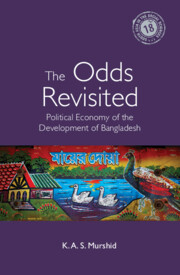Book contents
- Frontmatter
- Dedication
- Contents
- List of Tables and Figures
- Acknowledgements
- List of Abbreviations
- Introduction
- 1 A Bird’s-Eye View of the Bangladesh Economy: 1971–2020
- 2 Initial Conditions: The Odds Revisited
- 3 The Food Security Challenge
- 4 Exploring Transition and Change in the Rice Market
- 5 International Migration
- 6 The Rural Non-farm (RNF) Sector
- 7 Industrialization and the Rise of RMG
- 8 Industrialization: Other Stories
- 9 The Social Sector Puzzle
- 10 Dhaka: Capital Formation—Urbanization, Competition and the Rise of a Business Class
- Conclusion
- Notes
- Glossary
- References
- Index
3 - The Food Security Challenge
Published online by Cambridge University Press: 30 June 2022
- Frontmatter
- Dedication
- Contents
- List of Tables and Figures
- Acknowledgements
- List of Abbreviations
- Introduction
- 1 A Bird’s-Eye View of the Bangladesh Economy: 1971–2020
- 2 Initial Conditions: The Odds Revisited
- 3 The Food Security Challenge
- 4 Exploring Transition and Change in the Rice Market
- 5 International Migration
- 6 The Rural Non-farm (RNF) Sector
- 7 Industrialization and the Rise of RMG
- 8 Industrialization: Other Stories
- 9 The Social Sector Puzzle
- 10 Dhaka: Capital Formation—Urbanization, Competition and the Rise of a Business Class
- Conclusion
- Notes
- Glossary
- References
- Index
Summary
Rice is the staple food of the more than 165 million people of Bangladesh, with rice production continuing to dominate the country's agriculture. The share of agriculture in national GDP has been steadily declining over the years. In 2018–19 its contribution to GDP was 13.7 per cent, with crops accounting for slightly over 7 per cent and rice production dominating crop production (Government of Bangladesh 2020: 287). Rice accounts for two-thirds of calories, half of the protein intake and a similar share of the household budget of rural Bangladeshis. In terms of production, it accounts for almost 80 per cent of the cropped area (World Bank 2013). Thus, rice is crucial to Bangladesh's food security, with self-sufficiency in rice having been a major policy goal of the government for the last five decades.
Today, Bangladesh is self-sufficient on average, even managing to produce a surplus from time to time, a feat underscored by the fact that the population of the country more than doubled since 1972. Total rice production increased at a rate of about 3 per cent per year over the period 1972–73 to 2007–08, of which boro rice (the dominant rice crop) registered the highest growth of over 6.0 per cent per year. This was possible because of the GR technology of the 1970s and 1980s combined with market reforms and structural adjustments of the 1990s, and attention to the availability, quality and distribution of key inputs like diesel, fertilizers and seeds in more recent years (N. Ahmed et al. 2007; R. Ahmed et al. 2000).
This is a far cry from the early years when the Bangladesh economy was overwhelmingly rural and agricultural, with 90 per cent of the population living in rural areas and only 10 per cent in the towns, concentrated mainly in Dhaka and Chittagong. Agriculture's share of GDP was 60 per cent, and rice was the main crop grown in subsistence mode under traditional, rain-fed conditions. Jute was the main cash crop and the main foreign exchange earner accounting for 90 per cent of commodity exports. Industry was skeletal, mainly in the public domain, and run so badly that it was a constant drain on meagre public resources instead of making a contribution to the exchequer.
- Type
- Chapter
- Information
- The Odds RevisitedPolitical Economy of the Development of Bangladesh, pp. 48 - 57Publisher: Cambridge University PressPrint publication year: 2022



